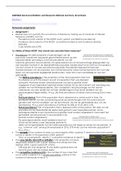-
1. Essay - Gzw1021 take home toets
-
2. Essay - Gzw1022 schrijfopdracht 'iets minder zitten is gezonder dan sporten'
-
3. Essay - Gzw1022 practicum rapport microbiële veiligheid en gezondheid
-
4. Essay - Gzw1242 (blok 1 gzw1021) filosofie in actie mini paper
-
5. Class notes - Gzw1242 filosofie in actie blok 1 gezondheid als norm: alle colleges
-
6. Summary - Gzw1021 training 1 en 2 levensloop en gezondheid
-
7. Presentation - Gzw1021 training levensloop en gezondheid presentatie tekst
-
8. Answers - Gzw1021 rapportageformulier training reactietijd
-
9. Other - Gzw1021 oefenvragen tentamen
-
10. Essay - Gzw1224 individueel eindverslag training het meten van voeding en bewegen
-
11. Essay - Gzw1023/gzw1024 eindproduct training kwalitatief onderzoek (kwalon)
-
12. Essay - Gzw1024 individuele analyse training kwalitatief onderzoek (kwalon)
-
13. Essay - Gzw1242 filosofie in actie blok 5 individuele fia toets
-
14. Essay - Gzw1025 practicum rapport dna
-
15. Essay - Gzw1025 schrijfopdracht nederlandse beliefs over genetische screening
-
16. Summary - Gzw1021 uitwerking alle taken
-
17. Answers - Gzw1026 samenvatting seminars
-
18. Other - Gzw1026 oefenvragen tentamen
-
19. Summary - Gzw1022 uitwerking alle taken
-
20. Summary - Gzw1023 uitwerking alle taken
-
21. Summary - Gzw1024 uitwerking alle taken
-
22. Presentation - Gzw1242 filosofie in actie blok 5 presentatie groepsopdracht retorische analyse
-
23. Class notes - Gzw1242 filosofie in actie blok 5 alle colleges
-
24. Summary - Gzw1242 filosofie in actie blok 5 bijeenkomst 1 en 2
-
25. Presentation - Gzw1242 filosofie in actie blok 1 presentatie plus uitwerking tekst
-
26. Summary - Gzw1242 filosofie in actie blok 1 bijeenkomst 1, 2 en 3
-
27. Summary - Gzw1022 training vraaggesprek met een chronisch zieke
-
28. Summary - Gzw1023 training methodologie voorbereiding bijeenkomsten
-
29. Summary - Gzw1025 uitwerking alle taken
-
30. Essay - Gzw1025 project dna eindverslag
-
31. Summary - Gzw1025 training project dna voorbereiding alle bijeenkomsten
-
32. Summary - Gzw1024 training het meten van voeding en bewegen voorbereiding alle bijeenkomsten
-
33. Essay - Gzw1024 training meten van voeding en bewegen onderzoeksopzet en poster
-
34. Essay - Gzw1026 final assignment
-
35. Summary - Bgz2021 uitwerking alle taken
-
36. Presentation - Fia 2.2 wetenschap in de maatschappij presentatie plus uitwerking tekst
-
37. Essay - Bgz2021 lekentekst, college lekentekst en handige tips!
-
38. Presentation - Bgz2021 project case report presentatie plus uitwerking tekst
-
39. Essay - Bgz2222 practicum verslag drna
-
40. Essay - Bgz2003 practicumverslag microbiologie antibioticaresistentie plus voorbereiding alle...
-
41. Essay - Bgz2024 essay practical biomarkers of protein intake
-
42. Essay - Gzw2224 phia 2.4 paper early prevention of juvenile delinquency and antisocial behavi...
-
43. Essay - Fia 2.1 & 2.2 individuele toets wetenschap en maatschappij en voorbereiding voor alle...
-
44. Essay - Gzw2225 phia 2.5 book review biology of desire and preparation for all the meetings
-
45. Summary - Bgz2022 uitwerking alle taken
-
46. Essay - Bgz2022 project paper en presentatie powerpoint (dna: mutaties pln gen)
-
47. Presentation - Bgz2023 poster project over teken
-
48. Summary - Bgz2024 summary all cases
-
49. Essay - Bgz2241 narrative review adipokines (obesity & muscle atrophy)
-
50. Summary - Bgz2023 uitwerking alle taken
-
51. Summary - Bgz2025 case 7 to 11
-
52. Summary - Bgz2025 case 1 to 6
-
53. Presentation - Bgz2025 presentation practical indirect calorimetry powerpoint and preparations for t...
-
54. Presentation - Bgz2025 presentation text and powerpoint training measuring physical activity and fit...
-
55. Summary - Bgz2026 summary all cases
-
56. Summary - Bgz2026 computer practicals
-
57. Presentation - Bgz2026 lab training --> assignment for paracetamol and powerpoint for beaker glas...
-
58. Presentation - Gzw3024 presentatie case 1 (powerpoint en tekst presentatie)
-
59. Presentation - Gzw3024 presentatie case 2 (powerpoint en tekst presentatie)
-
60. Thesis - Bgz3025 projectvoorstel/project proposal afstudeerscriptie
-
61. Essay - Gzw3224 filosofie in actie e-journal bgz groepsopdracht
-
62. Essay - Gzw3224 filosofie in actie e-journal bgz individuele opdracht
-
63. Thesis - Bgz3026 afstudeerscriptie biologie en gezondheid (bgz) gezondheidswetenschappen
-
64. Summary - Gzw3024 voortgezette statistiek en methoden van onderzoek samenvatting alle seminars
-
65. Essay - Gzw3226 afstudeerscriptie filosofie in actie opdracht
-
Show more




